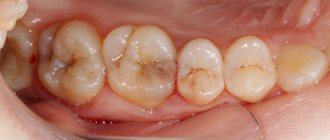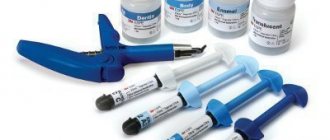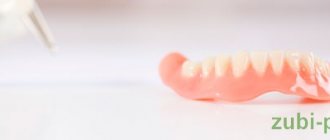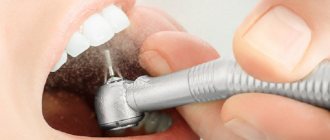Conventional chemical
The main difference between a simple (chemical) filling and a light filling is how they harden. A regular filling becomes hard due to a chemical reaction that occurs when different types of filling material are mixed. The result is a consistency with the required density and elasticity.
Cement fillings are strong and reliable, but the hardness of cement fillings is higher than the hardness of a tooth. Over time, fillings made from this material wear away the natural tooth enamel and destroy the teeth.
Dentists typically use two types of conventional chemical fillings:
- Composite - it contains several different chemical ingredients, which, when hardened, can differ significantly from the natural color of tooth enamel. The material hardens evenly, but does not last long - usually about 2 years.
- Glass ionomer - contains a special liquid and powder, which are mixed in the required proportion.
The composition hardens due to an acid reaction. Dentists can add additional components to this mixture as needed. Attention! Glass ionomer filling is good because it has the ability to release fluoride, which serves as a preventive measure against the re-development of caries.
About the quality of dental restoration using cement fillings
Everyone knows that the success of the treatment performed depends on the experience and qualifications of the dentist.
However, not everyone evaluates the quality and composition of the material used in the process of filling a tooth as a fundamental factor in the durability of the filling.
Read also: Is it possible to drink after dental anesthesia?
What is a cement filling, and how justified is such a choice? This will be discussed in this article.
The content of the article:
Light
In the professional language of dentists, there are several variations of names for this filling: light, light-composite, gel filling. These terms have a direct connection with the method of curing the filling material. The light seal hardens when exposed to ultraviolet radiation from a special lamp. The hardened material looks natural and aesthetically pleasing. It fits tightly to the edges of the teeth and guarantees long service life.
Light polymer fillings are the most modern type of fillings. They harden only under the influence of a special polymerization lamp, this allows the dentist to adjust the shape of the filling as accurately as possible.
The difference between light and conventional fillings also lies in the speed at which the material hardens. The components of the light filling polymerize under ultraviolet radiation and harden much faster than the ingredients of the chemical composition. It is very important for a dentist to do everything in 40 seconds. Otherwise, the filling material will begin to crack, since during the hardening process the dental canals are subjected to enormous stress from the inside. Dentists try to avoid this complication. To reduce the risk of cracks, filling material is applied to the canals in stages, in layers.
Attention! The main advantage of a light-curing filling is the ability to restore broken and completely destroyed teeth. The dentist can restore the natural shape of the tooth, its relief, and select the desired shade for full compatibility with the natural color of the enamel.
The light filling literally returns to the patient what seemed hopelessly lost - a realistic tooth and a smile without complexes. But there is also a minus. If the carious cavity is very deep, the dentist will not be able to perform light polymerization and will place a conventional chemical filling in the tooth.
General overview
Cement composite used in dentistry is made from a powder mixture and a liquid concentrated acid composition.
As a result of the combination of these elements, a mass is formed, characterized by a paste-like consistency, capable of hardening in a fairly short time.
- lower cost of the composite compared to alternative solutions;
- when working with cement, the use of complex devices and tools is not required;
- the procedure for forming the mass and its installation is carried out quickly and does not require special training of the dentist.
Cement fillings are not without their disadvantages:
- the hardened composite is unable to maintain its original shape and volume over a long period of time;
- the time required for the mass to completely harden is an order of magnitude longer than that of many modern filling compounds;
- poor resistance to external negative mechanical influence - unable to withstand the pressure exerted on them, the composition cracks and gradually loses its structural integrity;
- does not guarantee recurrent manifestations in the form of the development of repeated caries;
- in the process of incorrectly installing a filling, there is a risk of puncturing a part of a healthy organ;
- cement belongs to the category of toxic elements, and is not always biocompatible with natural tissues.
Drugs used for intraligamentary anesthesia and manipulation techniques.
Read reviews about dental treatment under a microscope here.
How much does a light seal cost?
Prices for dental work in reliable clinics are based on how complicated (or neglected) the tooth is. The cost of a light filling also depends on the condition of the tooth - the depth of the carious cavity, the degree of destruction of the walls, and the health of the canals. The more work the dentist requires, the higher the price will be. But the financial side of the issue may depend not only on the illness that the patient brought with him. If the clinic has a high status and brilliant authority, the price for a light filling may be too high. This is how reputable clinics maintain their status. Conversely, if a dental office has opened recently, and its main task is to attract customers, the price tags for services may be low.
This photo shows damaged teeth prepared for filling, as well as teeth after treatment and installation of light seals.
In general, the cost of a light-curing filling ranges from 2,000 to 15,000 rubles. But higher prices are also possible (as a rule, in cases where the tooth is too neglected). Filling the front teeth is always more expensive than the back teeth, because the smile area requires the highest quality and most expensive materials. The variety of dental clinics today is too great to not know where to go. Each patient decides for himself what to choose: either too expensive treatment, but with a guarantee of quality, or hope for a successful result and significant savings. There is a third option: price and quality in equal proportions - you need to choose this one. As a rule, many patients rely on reviews from friends and acquaintances, and on this basis they choose a clinic and a dentist. The most important thing is not to forget that a healthy smile is priceless.
Classification of filling materials
Fillings can be temporary or permanent.
A temporary filling serves to temporarily isolate a dental cavity with a medicinal drug introduced into it, and sometimes it itself contains this drug. Sometimes a temporary filling is applied because the doctor is not ready to completely rule out the development of pulpitis.
Temporary and permanent fillings differ in composition. To make temporary fillings, materials of less strength are used, this gives the doctor the opportunity to easily remove the filling during the next visit to the patient. Most often, such fillings are made from artificial dentin mixed with water.
Permanent fillings , if made from high-quality materials and installed in compliance with all requirements, can last for many years and even decades.
Installation process
Let's look at how dentists install a liquid filling:
- First you need to thoroughly treat the affected unit with a special disinfectant acid. This measure is necessary in order to completely destroy pathogenic microflora from the tooth. Next, you need to wait about 3 minutes for the enamel to dry.
- The tooth is coated with an alcohol-containing substance, this allows the remaining acid to be completely removed.
- Using a special syringe, a liquid filling is “poured” onto the tooth. Its composition penetrates into the deep layers of the tooth, thereby protecting the unit from further proliferation of pathogenic microorganisms. This must be done quickly so that the substance does not begin to harden from exposure to ordinary light.
- The filling is dried under a blue lamp; it is also sensitive to ordinary light. It is for this reason that it is stored exclusively in dark containers.
- At the end of the procedure, the unit is subjected to surface grinding and polishing.
The service life of a kind of dental sealant is from 5 years. If you want to install such a filling, please contact private medical centers.
Preparatory activities
Preliminary manipulations before installing a cement filling:
- a thorough inspection of the working surface for the presence of inflammatory formations, removal of plaque and rocky deposits so that their fragments do not fall into the tooth cavity and internal initiation does not occur;
- X-ray diagnostics - this is the only way to understand the true clinical picture and extent of the lesion;
- anesthesia and dissection of the damaged organ;
- preparation of the working area - it is expanded to the required size, given the necessary relief, sharp fragments and irregularities are ground off. All these measures will be the key to strong fixation of the mass;
- separation of the organ from neighboring units with a cotton swab or paper sponges - thus eliminating contact with salivary secretions, which negatively affects the quality and time of hardening of the cement mass;
- local-spectrum medications
- drying the treated part of the tooth with targeted air flows;
- if necessary, apply insulating material. To do this, using a cotton pad, dentin obtained by mixing distilled water and dentin powder in a ratio of 1:2 is evenly distributed along the bottom of the cavity. Then the remaining composition is removed with a special spatula;
If there is no need for a gasket, it is enough to simply treat the inner surface after its preparation with a special conditioner for 10 - 15 seconds. Then rinse well with water and dry thoroughly with air.
The main thing is to prevent the surface from becoming too dry, otherwise the adhesion strength of the cement to the inner surface of the hole will be worse.
What does aching teeth mean and the causes of the unpleasant phenomenon.
In this publication, we suggest that you familiarize yourself with the international classification of caries according to ICD 10.
Tooth preparation
This procedure includes the following manipulations:
- Treatment of affected tissues . All pigmented areas on enamel and dentin are carefully removed. In case of incomplete elimination, pigmented areas will appear against the background of the filling, and an attempt to cover them with a cement composition will not be successful.
- Formation of the enamel edge . When preparing cavities of classes 3-5, bevels are made on the enamel (their angle is 45°), which creates an imperceptible and smooth transition of the filling into the enamel. When the cavity belongs to classes 1 and 2, a fold is not made, since the cement wears out and wears out faster than the enamel layer.
- Removing deposits. Unremoved plaque prevents contact of the material with the hard tissues of the organ.
To improve adhesion, mechanical cleaning of formations from the enamel is carried out with a special brush, oil-free pastes (gels) or a device that removes deposits using a mixture of soda and water under pressure. Opening the enamel prism . Manipulation involves removing a thin structureless enamel layer covering the prismatic fascicles.
Such manipulation and further etching improve the adhesion of cement, especially when it is applied to erosive and hypoplastic areas of the enamel, or to a large area of fracture of the coronal part. Isolation from moisture and subsequent drying . This must be done carefully, as moisture reduces adhesion. The most effective device for isolating saliva, according to dentists, is a dental dam.
If this is not available, the doctor may use cotton swabs. When it is necessary to eliminate the possibility of liquid penetrating into the gingival cavity, special threads are used that are impregnated with a hemostatic compound.
- Applying a gasket (as indicated). It is covered with ionomer cement paste on top.
- Forming the foundation. Manipulation is carried out if there is a deep cavity, or pins will be installed. For these indications, a base is created from the composite and ionomer mass, which is then covered with a composite of the desired shade.
- Etching the enamel . The duration of the procedure should not exceed 20 seconds. Afterwards, the used acid (gel) must be carefully removed and the etching area dried with air.
- Primer application (if indicated only). It is introduced if the cavity reaches the dentin. The primer is applied with a special brush, and then (after about 20-30 seconds) non-volatile compounds of the drug are blown out with air.
- Adding adhesive mass. The adhesive composition is introduced into the cavity with a brush, and then distributed over the walls with air.
If it is two-component (i.e. chemically cured), no lamp treatment is performed. When the adhesive is one-component, i.e. light-curing, it is heated with a lamp for 10 seconds.










